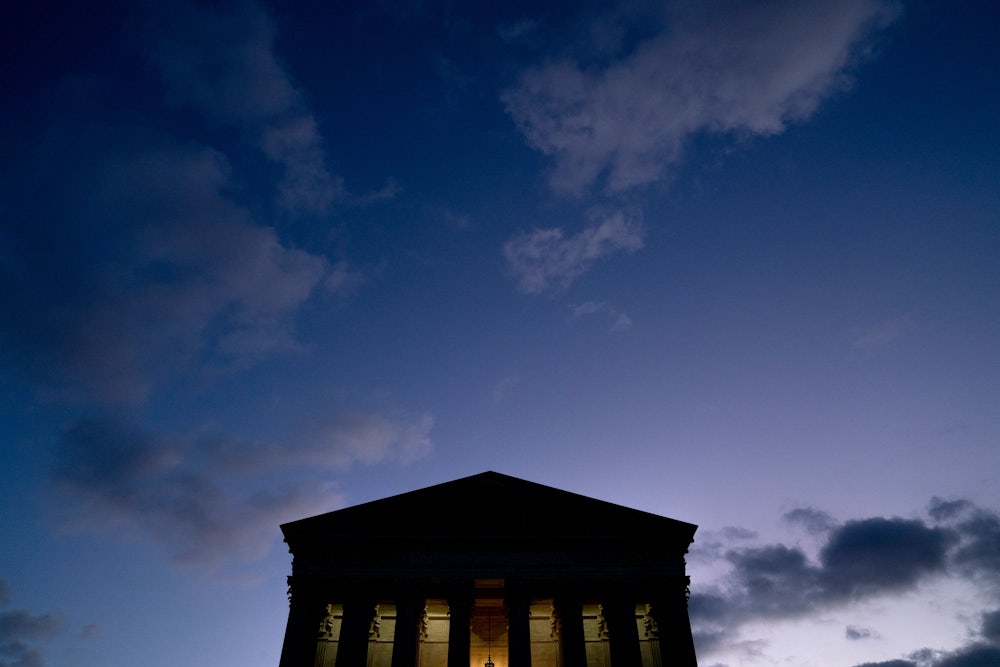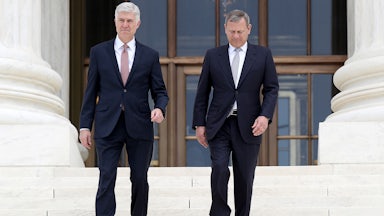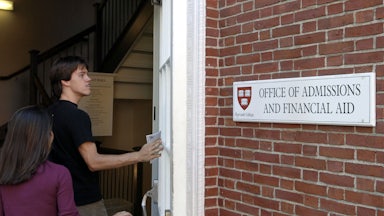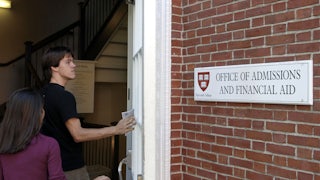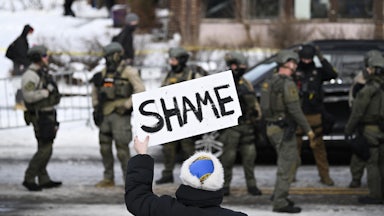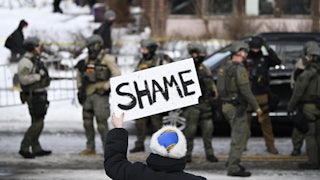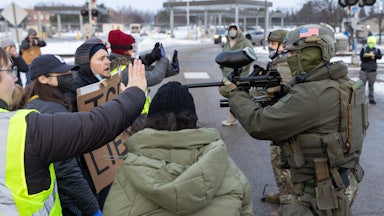The Supreme Court heard oral arguments on Monday in West Virginia v. Environmental Protection Agency, a case with potentially huge implications for U.S. climate policy. A coalition of energy companies and Republican-led states wants the justices to strike down the EPA’s ability to regulate greenhouse gas emissions by ruling that Congress didn’t explicitly grant the agency that power in the first place. That, in turn, would kneecap both U.S. and international efforts to limit carbon emissions. For all the big cases in the Supreme Court’s history, this may be the first one that affects, well, everything.
But it is also, strangely enough, a case about nothing at all. The plaintiffs have theorized that they might, at some point in the unspecified future, have a real complaint and ask the court to deal with that hypothetical possibility in a not-so-hypothetical way. The justices and their critics have recently discussed how the Supreme Court has lately handed down significant rulings from its so-called “shadow docket,” a catchy name for the court’s emergency-motions docket. Here we also see what we might call the phantom docket: speculative legal ventures, with phantasmal plaintiffs and hazy grounds for legal standing, which might nonetheless have lasting and far-reaching effects on the United States, depending on how they are decided.
The case is nominally about an Obama-era rule known as the Clean Power Plan, or CPP, which sought to regulate carbon emissions from power plants. The Supreme Court blocked it from taking effect in 2016 during an earlier legal challenge, and the Trump administration nixed it in 2019 in favor of its own policy, the Affordable Clean Energy, or ACE, Rule. After more litigation, the D.C. Circuit Court of Appeals tossed out the ACE Rule and restored the CPP. The Biden administration says it won’t bring back the CPP and instead plans to write an all-new policy to replace both the Obama-era and Trump-era rules.
That should be the end of it, right? In theory, the Supreme Court generally hears cases where one party injures another in some way and the court has a way to remedy the claim. By requiring the court to only hear “cases and controversies,” the Constitution implicitly forbids it from issuing advisory opinions with no stakes and no consequences. With neither the ACE Rule nor the CPP taking effect, there is no injury for anybody to resolve—and, perhaps, no legal standing to challenge it. But the companies and the states that are suing the EPA still argued that the court should resolve the issue. It will probably come up again in the future, they said, and there’s no sense waiting around for the lengthy regulatory process to unfold to rule against it.
“It may thus be 2025 (or later) before the Court could next provide much-needed clarity,” the states estimated for the court in their petition. “Yet taking up the issue now would put a definitive resolution in reach no later than June 2022—allowing EPA to propose a rule on a similar timeframe as the CPP rulemaking, but this time with certainty in its legal footing.” (Again, the “certainty” they seek is the EPA’s inability to do it at all.) West Virginia Solicitor General Lindsay See put their reasoning even more succinctly at oral arguments. “Standing is no reason to avoid the merits,” she told the justices.
The federal government strongly encouraged the justices to resist the urge to decide the case now. The companies and the states, the Justice Department noted, “are not currently subject to any federal greenhouse-gas restrictions” and there is “substantial uncertainty about the contours of the upcoming EPA rule.” In short, the department said, they “ask the Court to pronounce on the validity of hypothetical regulatory provisions that the agency might—but very well might not—adopt.” In other words, an advisory opinion that would nonetheless be binding on the EPA.
West Virginia v. EPA isn’t the only case on the court’s phantom docket these days. Last week I wrote about the justices’ decision to take up 303 Social v. Elenis, a case with major implications for LGBT rights in particular and anti-discrimination laws in general. A Christian web designer in Colorado is suing the state’s civil rights commission to block it from enforcing a state law that forbids companies from discriminating on the basis of sexual orientation. Citing her faith, she argued that the law would compel her to make wedding websites for same-sex couples.
This isn’t unfamiliar terrain for the Supreme Court. It previously considered a similar case in 2018 on the relationship between religious freedom and LGBT rights. But this version of the case is striking for the exceptionally low real-world stakes. The plaintiff has never designed wedding websites before, has never been asked to design one for a same-sex couple, and has never been sanctioned by the state civil rights commission for doing so. Her injury, so to speak, is entirely hypothetical. And while there is no reason to doubt the sincerity of her beliefs, there is also no evidence that they are being abridged or denied in any way at the moment. She may still give the Supreme Court an opportunity to radically reshape the scope of anti-discrimination laws—a feat perhaps made more palatable when there is no discriminated-against party who could speak up.
It’s important not to paint with too broad a brush here. Legal activists from across the political spectrum often use test cases that intentionally challenge a law or regulation in the hope of getting a court to overturn it. They can range from the gay and lesbian couples in Obergefell v. Hodges who sought marriage equality to the retired police officer in D.C. v. Heller who couldn’t keep a non-disassembled handgun in his home for self-defense. Those cases have stakes that go beyond an abstract legal ruling and a weight that can justify a court’s intervention.
Some test cases can be based on even more threadbare arguments for standing. Consider the saga of Abigail Fisher, whose lawsuit against the University of Texas system reached the Supreme Court twice in the 2010s. Fisher, who is white, was denied admission to the University of Texas at Austin in 2008. She argued that the system’s race-conscious admissions policy at the time, which automatically admitted all Texas students who placed in the top 10 percent of their respective high school classes, had discriminated against her on the basis of race. The case amounted to the first major legal challenge to affirmative action in higher education in a decade.
By the time the case reached the Supreme Court for a second time in 2016, however, Fisher had been admitted to Louisiana State University, attended classes there, and graduated from it with a bachelor’s degree in finance. So why was her legal case still viable after all those years? Fisher sought exactly $100 from the University of Texas system—the price of her college admissions fee. On that small payment rested a case that, for a time, looked like it could upend affirmative action policies across the U.S.
At the time, UT Austin raised questions about whether Fisher’s case was an appropriate one to raise. “There is also a serious question as to whether [Fisher] is an appropriate plaintiff at all to challenge UT’s policy,” they told the court when it considered whether to take up her case for a second time in 2015. “As discussed, the record establishes that, with her AI score of 3.1, [Fisher] would not have been admitted to the Fall 2008 class no matter what her race, given the strong competition that year. As the Fifth Circuit recognized, this fact creates a serious question about whether petitioner has standing, or could establish that she was injured by the policy even if a violation were proved.”
Supporting Fisher along the way was Ed Blum, a conservative legal activist with a successful track record of organizing lawsuits that target civil rights laws and anti-discrimination policies. His latest campaign is against Harvard University and the University of North Carolina, whose race-conscious admissions policies, he argued, unfairly discriminate against prospective Asian applicants. Blum, who is white, founded the organization Students for Fair Admissions to pursue those claims in court.
His role in the litigation prompted some pushback from Harvard University, which argued that he lacked standing to bring the case before the Supreme Court. “SFFA is not a genuine membership organization—it is a vehicle designed to advance the policy preferences of its controlling founder, who has no personal stake in the controversy,” Harvard said, referring to Blum. “And even if there were doubt on that score, it would be prudent for the Court to defer the sweeping claims SFFA presents until clearly raised by a party with a genuine stake in the outcome.”
Blum and his organization rejected that characterization, telling the court that their organization genuinely represents students who believe they were unfairly denied admission on the basis of race; his group touts more than 20,000 members. “The Court routinely decides cases brought by membership associations,” SFFA wrote in a reply brief. “And Harvard knows that individuals’ claims for prospective relief expire once they graduate, and that few young adults could endure the threats, insults, and harassment that Abigail Fisher suffered.”
Harvard disputed SFFA’s claims that it was a legitimate organization, casting it instead as a front for his legal activism. “SFFA identified ‘member’ applicants who were rejected by Harvard or who might apply in the future as the basis of its standing, but neither these nor any other members control, direct, or finance the organization,” the university told the court. “SFFA’s initial ‘members’ had no role in selecting board members or officers and contributed virtually nothing monetarily. The organization—and this litigation—were instead controlled, directed, and financed by bystanders with no personal stake. Even after SFFA’s minimal post-suit changes to its structure, its purported members still play no meaningful role.”
That appeared to be insufficient to dissuade the justices, who agreed to hear the case last month. They still might reject SFFA’s claims on standing grounds, just as they could for the red-state coalition in the climate change case and for the Christian web designer in the anti-discrimination case. Maybe they’ll rule that parties need to bring more concrete claims before the court and decline to resolve major constitutional questions for phantasmal litigants or hypothetical injuries. Or maybe, in their haste to reshape American law in their own image, the justices will simply take whatever they can get and rule accordingly.
